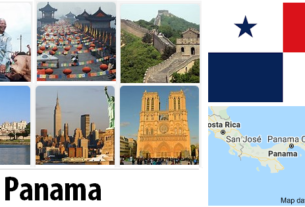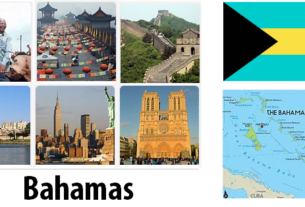The name of Honduras comes from the gulf that marks the NW end. on the Atlantic, where it offered the first western navigators (Columbus who discovered it and Pinzón-Solis who would have baptized it) one of the best landings that offered, due to the conditions of the bottom (hondo, and hence honduras, or backdrop), on this side the region of the isthmuses.
According to neovideogames, the coast of Honduras was discovered by Christopher Columbus, when on 20 July 1502 (fourth expedition) from the islet Guanaja he touched what is now called Cape Honduras; in the following days the whole continuation of the coast was recognized at noon continuing towards the Darien. In 1508-9 the expedition of Juan Diaz de Solis completes the discovery to the north, from Cape Honduras to the west. The occupation of Mexico by Hernan Cortés then provokes other more complete explorations: in 1522 Gil González de Ávila discovers the southern coast, Cristóbal de Olid completes the discovery in 1524. From 1535 onwards the discovery begins and is made. conquest of the interior, entrusted especially to Olid, to Pedro Alvarado, to Juan Chaves, to Hernández de Córdoba.
On the extension of the northern coast, which extends for over 650 km. from the mouth of the Motagua to C. Gracias á Dios on the delta of Segovia (or Yoro), the thin (95 km.) strip included in the borders of the state contrasts with the Pacific, all closed within the Bay of Fonseca, which they overlook together, on the opposite sides, Salvador and Nicaragua, the first of which follows the southern border of Honduras. Except for the latter, the borders with the neighboring republics have given rise to interminable disputes, favored by the lack or deficiency of precise surveys and by the uncertainty of the same historical data on which the conflicting claims are based. Particularly serious is the question as regards the NW extremity, where the Guatemalans, far from accepting Motagua as a border,
Climate. – The climatic conditions of Honduras are still very imperfectly known, given the scarcity and little reliability of the data available, but there is no doubt that, in comparison with the other republics of Central America, the originality of this The zone consists above all in the influence that the predominantly latitudinal arrangement of the relief exerts on the distribution and quantity of rainfall, which stops the benefits of the NE trade wind coming from the humidity-laden Atlantic on the coastal strip. Along this strip, the typical conditions of the whole area of the isthmus are repeated: annual averages of very high temperatures (around 26 °; daytime and monthly excursions are very weak), with abundant rains (generally higher than 4 m. annually) and distributed in each month of the year. A dry season only occurs at the extreme edge of the Pacific, where temperatures remain almost the same or just below, but the rainfall decreases considerably (950-1500 mm. Per year), concentrating almost entirely between June and October, while from December to April it falls only from 1 / 15 to 1 / 20 of the total. Throughout the rest of the country, the contrast between the regions beaten by the humid current of the trade wind and those that remain more or less sheltered from it translates into a great variety of types of vegetation: as a general trend, the savannah and xerophilous associations they are spreading more and more as you move away from the coast line. In the capital, which occupies a slightly eccentric position with respect to this area, the average annual temperature fluctuates around 23 ° (January 19 °, May 24 °, 5, maximum 36 °, 6, minimum 7 °, 8), while rainfall is just over 1200 mm.
Flora. – In the temperate zone, fir and broad-leaved woods abound which provide useful woods for construction, cabinet-making and dyeing: cedars, pines, caoba, pink pole, oaks, Anacardiaceae, Sapotaceae, ceiba, mangle, guaiac, laurel, ebony, walnut, passionflower, pole de moral (Morus tinctoria), amarillo sandalwood, camping, dragon’s blood. There is no shortage of balsam and gum resin plants: Copaifera, Liquidambar and on the coasts there are woods of Castilloa, which once had importance as a supplier of elastic rubber. Among the medicinal plants we can mention the ipecacuana and the sarsaparilla: this is of the best known quality and it is widely exported. Among the cultivated plants we will point out cereals, which are the same as in other countries, and then coffee, sugar cane, cocoa, tobacco, indigo, bananas (exported in large quantities to the United States), citrus fruits (oranges, lemons, limes, limes), tamarind, papaya. The vegetation has great affinities with that of neighboring countries: Nicaragua, San Salvador, Guatemala.
Fauna. – The fauna of Honduras has very few peculiar characters since they are species common to the whole Mexican sub-region of the neotropic region. Among the Mammals various platyrrhine monkeys and various species of bats; some insectivores and among the carnivores the jaguar, the undi, various martens, raccoons, etc. Rodents are represented by species common to South America and among these we will mention those belonging to the Octodontids and Dasiproctids. Among the ungulates the tapirs, the peccaries. Armadillos, anteaters among the Toothless and various Marsupials are also noteworthy for the fauna of the region. Birds include a large number of species belonging to almost all the families of the neotropic avifauna, but many forms are missing such as ants, toucans, ree, etc. Amblystoma, some species of gen. Spelerpes). Various species of freshwater fish and the world of invertebrates is very rich with various forms of insects, spiders, myriapods and terrestrial molluscs.
Agriculture. – Like the other republics of Central America, Honduras is essentially an agricultural country, having hitherto exercised the mining industry only a secondary influence on the general economy, although this is, in terms of mineral wealth, the best favored state in the whole area of the isthmus. Common with the finitime regions is also the tendency to affirm more and more clearly the prevalence of one or a few crops over all the others: in the case of Honduras, the banana ended up absorbing by itself more than two thirds (in 1929-30 87.8%) of the value of the exported goods. The plantations occupy the lower area near the Atlantic coast and the facing islands, forming a continuous strip, locally deep even over a hundred km., From the Guatemalan border to the mouth of the Río Patuca: here the North American companies; who have given development to the crop itself, have built a whole railway communications network for the disposal of the products, which are ready and safely sold on the markets of the neighboring United States (74% in value of this export was placed here in 1929-30). Until 1916 the first place among the republics of Central America as a producer of bananas was held by Costa Rica; after that date, the participation of Honduras, which then represented less than 1 / 5 of the average American total, grew continuously until it touches 1 / 3 in 1920, about 1 / 2 in 1926 and surpass this figure in 1929-30, the quantity which is now around 25-30 million bunches, for a value of 12-15 million dollars.
Great development has taken in recent years sugar cane, also cultivated in the Atlantic area, where only poor sanitary conditions (malaria) have prevented and delayed a greater extension of the crop. The export of refined sugar varies from year to year, but after 1926 the quantities exceeded those of the neighboring republics (20.7 million kg. In 1927, against 10.1 million in Nicaragua), representing in 1929-30 about half of Central American production.
The cultivation of coffee, on the other hand, is less important, concentrated in the inland regions of Danlí, San Marcos de Colón and Santa Bárbara; the lack of communication routes (the product finds its outlet towards S. at the port of Amapala) seems to have been the determining factor up to now for the poor luck of the plantations. The quantities exported represent a very small percentage (1 / 30 – 1 / 40) of the total and are lower (3.4 and 3.1 mil. Of pounds) to those of other states of the isthmic area.
Finally, besides the plants destined for local food (corn and potatoes above all), the tobacco crops (20-30 thousand quintals), widespread in the departamentos of Copán, Santa Bárbara, El Paraíso, Ocotepeque, Gracias, are far from negligible. and in the Danlí region), coconuts (on average 10-15 million kg. of nuts and 250 thousand kg. of copra) and cocoa (on the hills between the Ulúa and Cuero rivers there are about 28 thousand plants), but still more remarkable the importance outlet breeding (valley of Olancho), especially cattle (over 1 / 2 million heads), which allows, among other things, a fair amount of skins for export (immediately after the Guatemala among the Central American states). On the other hand, the value (1/ 40 of the total) which in foreign trade have forest products (liquidambar, corozo, rubber, mahogany, etc.).
Mines. – As mentioned, the subsoil is very rich in useful minerals. The extraction of precious ones (especially gold and silver) dates back to the century. XVII, but suffered a long period of arrest, until it was recovered with modern methods. Although the deposits are very numerous (provinces of Yuscarán, Tegucigalpa, Choluteca, El Valle, Copán and Olancho) and various (antimony, iron, malachite, opal, copper, platinum, and even oil), only those of the San Juancito region, where North American capital intervened, they gave rise to rational exploitation and only silver, it can be said, appears with considerable figures among the items of exports (1.53 million dollars in 1925-26 and 1.38 in 1926 and 1927).



